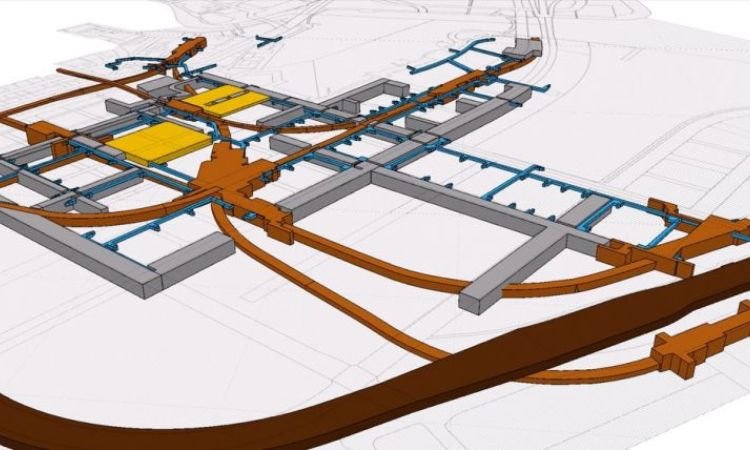
The global underground utility mapping market size is estimated to be worth USD 1459.04 million in 2024 and is expected to reach USD 4333.27 million by 2034, increasing at a CAGR of 11.50% between 2025 and 2034. As cities and infrastructure projects continue to grow, the demand for accurate, efficient, and reliable methods of detecting and mapping underground utilities is skyrocketing. The advancement of technologies such as Electromagnetic Induction (EMI) and Ground Penetrating Radar (GPR) is driving this growth, enabling industries to conduct safer, more efficient construction, maintenance, and repair operations. In this blog post, we will explore the key trends, technological solutions, market segmentation, regional dynamics, and future outlook for the underground utility mapping market between 2025 and 2034.
Market Overview
Underground utility mapping involves the identification, location, and mapping of utilities such as pipelines, cables, and other essential infrastructure buried below the surface. With increasing urbanization and the growing need for infrastructure maintenance and repair, the demand for underground utility mapping has surged. Mapping technologies help prevent utility strikes during construction and renovation, thereby improving safety, reducing downtime, and minimizing costs.
The market growth is driven by factors such as the global increase in infrastructure development, heightened safety standards, and advancements in geophysical technologies. Additionally, industries like oil and gas, construction, and utilities rely heavily on underground utility mapping to avoid costly damages and enhance operational efficiency.
Market Segmentation
By Technological Solution
The underground utility mapping market is driven by several advanced technological solutions that are increasingly being adopted across industries. The primary solutions include Electromagnetic Induction (EMI), Ground Penetrating Radar (GPR), and other emerging technologies.
Electromagnetic Induction (EMI)
Electromagnetic Induction (EMI) is one of the most widely used methods for detecting underground utilities. This technology works by emitting electromagnetic signals and measuring the response to determine the location and depth of utilities. EMI offers high accuracy, especially when mapping metallic utilities like pipelines and cables. Due to its reliability and speed, EMI is expected to continue dominating the market, particularly in regions with high urban development.
Ground Penetrating Radar (GPR)
Ground Penetrating Radar (GPR) uses radar pulses to image the subsurface and detect utilities. GPR is effective in locating both metallic and non-metallic utilities, making it a versatile tool for underground mapping. With advancements in radar technology, GPR systems are becoming more portable, precise, and cost-effective. This makes GPR an increasingly attractive option for utility mapping in urban areas, construction sites, and areas where utilities may not be clearly marked.
Others
In addition to EMI and GPR, other emerging technologies, such as acoustic sensors, GPS-based systems, and drones, are being integrated into utility mapping solutions. These innovations offer added flexibility and precision, particularly in challenging environments like remote or congested urban areas. As these technologies mature, they will further enhance the overall capabilities of underground utility mapping.
By Components
The underground utility mapping market consists of two main components: technological solutions and services.
Technological Solutions
Technological solutions encompass the hardware and software tools used in underground utility mapping. These tools include EMI and GPR devices, along with associated data processing software. Advanced mapping software integrates AI and machine learning to help users analyze the data collected, improving the overall accuracy and efficiency of utility mapping projects. As software solutions become more sophisticated, they are expected to play an increasingly critical role in the market.
Services
The service segment of the underground utility mapping market includes data collection, analysis, and interpretation services. Service providers help businesses and governments ensure that the utility mapping is accurate and compliant with regulations. These services can range from site surveys and data collection to in-depth reports and ongoing monitoring.
By Services
The services segment is further divided into two primary categories: professional services and managed services.
Professional Services
Professional services include consulting, training, and project management. These services are essential for businesses seeking to implement underground utility mapping solutions effectively. Consulting services help companies determine the best technologies for their specific needs, while training services ensure that staff members are equipped to handle mapping tools. Project management services ensure that utility mapping projects are completed on time and within budget.
Managed Services
Managed services refer to the outsourcing of utility mapping tasks to specialized third-party providers. By leveraging managed services, businesses can reduce costs, improve efficiency, and access the latest mapping technologies without the need for heavy investments in equipment and software. As the demand for utility mapping grows, managed services are likely to become increasingly popular, especially among small and medium-sized enterprises (SMEs).
By End Use
The end-use segment of the underground utility mapping market includes industries such as oil and gas, construction, transportation, and utilities.
Oil and Gas
The oil and gas industry is a major consumer of underground utility mapping services. Accurate utility mapping helps mitigate the risk of damaging existing pipelines, cables, and other infrastructure during drilling, exploration, and transportation activities. Utility mapping is also critical for regulatory compliance and ensuring the safety of workers. The demand for utility mapping in the oil and gas sector is expected to grow significantly during the forecast period, driven by ongoing exploration activities and infrastructure development.
Others
Apart from oil and gas, other industries such as construction, telecommunications, transportation, and utilities also rely heavily on underground utility mapping. These industries need to accurately map utilities to avoid disruptions, comply with safety standards, and optimize their operations. As infrastructure projects continue to proliferate, the demand for utility mapping services in these sectors will increase.
Regional Analysis
North America
North America, particularly the United States and Canada, is one of the largest markets for underground utility mapping. The region has a well-established infrastructure industry and an increasing number of construction projects. The adoption of advanced technologies like GPR and EMI, coupled with stringent safety regulations, is driving market growth in North America. Additionally, the oil and gas sector’s continued expansion in this region contributes significantly to the demand for utility mapping services.
Europe
Europe is another key market for underground utility mapping, with significant demand stemming from construction, infrastructure development, and transportation projects. Countries like the UK, Germany, and France are actively adopting advanced mapping technologies to ensure safety and regulatory compliance. Additionally, the push towards smart cities and urban renewal projects is expected to boost demand for utility mapping solutions in the region.
Asia-Pacific
The Asia-Pacific region is expected to experience the highest growth in the underground utility mapping market between 2025 and 2034. Rapid urbanization, increased infrastructure spending, and industrial development are driving the demand for accurate utility mapping solutions. China, India, Japan, and Australia are all key markets, with growing adoption of GPR and EMI technologies.
Latin America & Middle East
In Latin America and the Middle East, the market is primarily driven by the oil and gas industry, where accurate mapping is essential to ensure the safety and efficiency of pipeline operations. In addition, expanding urban infrastructure projects in cities like São Paulo, Dubai, and Riyadh are increasing the need for advanced mapping technologies.
Market Dynamics
Drivers
- Urbanization and Infrastructure Growth: The rapid expansion of urban areas and infrastructure projects globally is a significant driver for the underground utility mapping market. Accurate mapping ensures safer construction, repairs, and maintenance.
- Safety and Regulatory Compliance: With stricter safety regulations across industries, especially in construction and oil and gas, utility mapping plays a crucial role in preventing utility strikes, ensuring worker safety, and complying with regulations.
- Technological Advancements: The integration of AI, machine learning, and automation in utility mapping technologies is improving their precision and efficiency, driving market growth.
Restraints
- High Initial Investment: The cost of adopting advanced underground utility mapping technologies can be a barrier for small businesses and contractors, limiting market penetration in some regions.
- Data Interpretation Challenges: While the technologies used for utility mapping are highly accurate, interpreting the data correctly can be complex and requires skilled professionals.
Opportunities
- Emerging Markets: Developing regions, particularly in Asia-Pacific and Africa, present significant growth opportunities for the underground utility mapping market.
- Smart Cities: The integration of utility mapping in smart city development is a major opportunity, as urban planners seek to incorporate accurate, real-time data to optimize infrastructure planning and management.
Threats
- Technological Obsolescence: Rapid technological advancements may lead to older mapping solutions becoming obsolete, making it necessary for businesses to stay updated with the latest tools.
- Competition from Alternative Technologies: Other methods, such as visual inspections or manual surveys, may compete with underground utility mapping in certain regions, especially in cost-sensitive markets.
Competitive Landscape
The underground utility mapping market is highly competitive, with several key players dominating the landscape. These companies are focusing on strategic initiatives such as partnerships, acquisitions, and technological innovations to strengthen their market position. Companies like Leica Geosystems, Geophysical Survey Systems Inc. (GSSI), and 3M are leading the way in providing cutting-edge mapping solutions and services.
Future Outlook and Forecast (2025-2034)
The global underground utility mapping market is expected to continue growing at a robust pace between 2025 and 2034. With technological innovations, increasing demand from emerging markets, and the continued need for safety and efficiency in infrastructure projects, the market’s projected CAGR of 11.50% indicates a promising future. The integration of AI, machine learning, and smart city initiatives will further drive the adoption of advanced mapping solutions, ensuring the market’s expansion in the coming decade.


